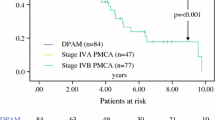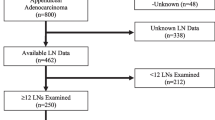Abstract
Background
The AJCC 8th edition stratifies stage IV disseminated appendiceal cancer (dAC) patients based on grade and pathology. This study was designed to externally validate the staging system and to identify predictors of long-term survival.
Methods
A 12-institution cohort of dAC patients treated with CRS ± HIPEC was retrospectively analyzed. Overall survival (OS) and recurrence-free survival (RFS) were analyzed by using Kaplan-Meier and log-rank tests. Univariate and multivariate cox-regression was performed to assess factors associated with OS and RFS.
Results
Among 1009 patients, 708 had stage IVA and 301 had stage IVB disease. Median OS (120.4 mo vs. 47.2 mo) and RFS (79.3 mo vs. 19.8 mo) was significantly higher in stage IVA compared with IVB patients (p < 0.0001). RFS was greater among IVA-M1a (acellular mucin only) than IV M1b/G1 (well-differentiated cellular dissemination) patients (NR vs. 64 mo, p = 0.0004). Survival significantly differed between mucinous and nonmucinous tumors (OS 106.1 mo vs. 41.0 mo; RFS 46.7 mo vs. 21.2 mo, p < 0.05), and OS differed between well, moderate, and poorly differentiated (120.4 mo vs. 56.3 mo vs. 32.9 mo, p < 0.05). Both stage and grade were independent predictors of OS and RFS on multivariate analysis. Acellular mucin and mucinous histology were associated with better OS and RFS on univariate analysis only.
Conclusions
AJCC 8th edition performed well in predicting outcomes in this large cohort of dAC patients treated with CRS ± HIPEC. Separation of stage IVA patients based on the presence of acellular mucin improved prognostication, which may inform treatment and long-term, follow-up strategies.



Similar content being viewed by others
Data Availability
It is the policy of the United States HIPEC Collaborative that the data compiled in the multi-institutional database are not to be shared.
References
Amin MBES, Greene F, Byrd DR, Brookland RK, Washington MK, Gershenwald JE, Compton CC, Hess KR, et al. AJCC Cancer Staging Manual. 8th edn. American Joint Commission on Cancer: Springer International Publishing; 2017.
Asare EA, Compton CC, Hanna NN, et al. The impact of stage, grade, and mucinous histology on the efficacy of systemic chemotherapy in adenocarcinomas of the appendix: analysis of the national cancer data base. Cancer. 2016;122(2):213–21.
Overman MJ, Fournier K, Hu CY, et al. Improving the AJCC/TNM staging for adenocarcinomas of the appendix: the prognostic impact of histological grade. Ann Surg. 2013;257(6):1072–8.
Edge SB, Compton CC. The American Joint Committee on Cancer: the 7th edition of the AJCC cancer staging manual and the future of TNM. Ann Surg Oncol. 2010;17(6):1471–4.
Amin MB, Greene FL, Edge SB, et al. The eighth edition AJCC cancer staging manual: continuing to build a bridge from a population-based to a more “personalized” approach to cancer staging: the eighth edition AJCC cancer staging manual. CA Cancer J Clin. 2017;67(2):93–9. https://doi.org/10.3322/caac.21388.
Jackson SL, Fleming RA, Loggie BW, Geisinger KR. Gelatinous ascites: a cytohistologic study of pseudomyxoma peritonei in 67 patients. Mod Pathol. 2001;14(7):664–71.
Pai RK, Beck AH, Norton JA, Longacre TA. Appendiceal mucinous neoplasms: clinicopathologic study of 116 cases with analysis of factors predicting recurrence. Am J Surg Pathol. 2009;33(10):1425–39.
Carr NJ, McCarthy WF, Sobin LH. Epithelial noncarcinoid tumors and tumor-like lesions of the appendix. A clinicopathologic study of 184 patients with a multivariate analysis of prognostic factors. Cancer. 1995;75(3):757–68.
Beal EW, Ahmed A, Grotz T, et al. Trends in the indications for and short-term outcomes of cytoreductive surgery with hyperthermic intraperitoneal chemotherapy. Am J Surg. 2020;219(3):478–83.
Overman MJ, Kakar S, Carr NJ, et al. AJCC cancer staging system: appendix: version 9 of AJCC cancer staging system. In: Washington MK, ed: American College of Surgeons; 9th edition (2022); 2022.
Bradley RF, Stewart JH, Russell GB, Levine EA, Geisinger KR. Pseudomyxoma peritonei of appendiceal origin: a clinicopathologic analysis of 101 patients uniformly treated at a single institution, with literature review. Am J Surg Pathol. 2006;30(5):551–9.
Misdraji J, Yantiss RK, Graeme-Cook FM, Balis UJ, Young RH. Appendiceal mucinous neoplasms: a clinicopathologic analysis of 107 cases. Am J Surg Pathol. 2003;27(8):1089–103.
Baratti D, Kusamura S, Nonaka D, et al. Pseudomyxoma peritonei: clinical pathological and biological prognostic factors in patients treated with cytoreductive surgery and hyperthermic intraperitoneal chemotherapy (HIPEC). Ann Surg Oncol. 2008;15(2):526–34.
Davison JM, Choudry HA, Pingpank JF, et al. Clinicopathologic and molecular analysis of disseminated appendiceal mucinous neoplasms: identification of factors predicting survival and proposed criteria for a three-tiered assessment of tumor grade. Mod Pathol. 2014;27(11):1521–39.
Mulvany N, Ooi K. Pseudomyxoma peritonei: a cytohistopathologic study of nine cases. Diagn Cytopathol. 1996;15(2):144–50.
Grotz TE, Overman MJ, Eng C, et al. Cytoreductive surgery and hyperthermic intraperitoneal chemotherapy for moderately and poorly differentiated appendiceal adenocarcinoma: survival outcomes and patient selection. Ann Surg Oncol. 2017;24(9):2646–54.
Xie X, Zhou Z, Song Y, et al. The management and prognostic prediction of adenocarcinoma of appendix. Sci Rep. 2016;6:39027.
Garach NR, Kusamura S, Guaglio M, Bartolini V, Deraco M, Baratti D. Comparative study of mucinous and non-mucinous appendiceal neoplasms with peritoneal dissemination treated by cyoreductive surgery and hyperthermic intraperitoneal chemotherapy (HIPEC). Eur J Surg Oncol. 2021;47(5):1132–9.
Chua TC, Moran BJ, Sugarbaker PH, et al. Early- and long-term outcome data of patients with Pseudomyxoma peritonei from appendiceal origin treated by a strategy of cytoreductive surgery and hyperthermic intraperitoneal chemotherapy. J Clin Oncol. 2012;30(20):2449–56.
Sinukumar S, Mehta S, As R, et al. Analysis of clinical outcomes of pseudomyxoma peritonei from appendicular origin following cytoreductive surgery and hyperthermic intraperitoneal chemotherapy: a retrospective study from INDEPSO. Indian J Surg Oncol. 2019;10(Suppl 1):65–70.
Chen JC, Beal EW, Hays J, Pawlik TM, Abdel-Misih S, Cloyd JM. Outcomes of neoadjuvant chemotherapy before CRS-HIPEC for patients with appendiceal cancer. J Surg Oncol. 2020;122(3):388–98.
Aziz O, Jaradat I, Chakrabarty B, et al. Predicting survival after cytoreductive surgery and hyperthermic intraperitoneal chemotherapy for appendix adenocarcinoma. Dis Colon Rectum. 2018;61(7):795–802.
Elias D, Gilly F, Quenet F, et al. Pseudomyxoma peritonei: a French multicentric study of 301 patients treated with cytoreductive surgery and intraperitoneal chemotherapy. Eur J Surg Oncol. 2010;36(5):456–62.
Jimenez W, Sardi A, Nieroda C, et al. Predictive and prognostic survival factors in peritoneal carcinomatosis from appendiceal cancer after cytoreductive surgery with hyperthermic intraperitoneal chemotherapy. Ann Surg Oncol. 2014;21(13):4218–25.
Votanopoulos KI, Russell G, Randle RW, Shen P, Stewart JH, Levine EA. Peritoneal surface disease (PSD) from appendiceal cancer treated with cytoreductive surgery (CRS) and hyperthermic intraperitoneal chemotherapy (HIPEC): overview of 481 cases. Ann Surg Oncol. 2015;22(4):1274–9.
Halabi HE, Gushchin V, Francis J, et al. Prognostic significance of lymph node metastases in patients with high-grade appendiceal cancer. Ann Surg Oncol. 2012;19(1):122–5.
Turner KM, Morris MC, Delman AM, et al. Do lymph node metastases matter in appendiceal cancer with peritoneal carcinomatosis? A US HIPEC collaborative study. J Gastrointest Surg. 2022;26(12):2569–78.
Levinsky NC, Morris MC, Wima K, et al. Should we be doing cytoreductive surgery with HIPEC for signet ring cell appendiceal adenocarcinoma? A study from the US HIPEC collaborative. J Gastrointest Surg. 2020;24(1):155–64.
Funding
This research did not receive any specific grant from funding agencies in the public, commercial, or not-for-profit sectors.
Author information
Authors and Affiliations
Corresponding author
Ethics declarations
Disclosure
No relevant disclosures.
Additional information
Publisher's Note
Springer Nature remains neutral with regard to jurisdictional claims in published maps and institutional affiliations.
Supplementary Information
Below is the link to the electronic supplementary material.
10434_2023_13697_MOESM1_ESM.pdf
Supplemental Fig. 1 Kaplan-Meier curves of (A) overall survival and (B) recurrence-free survival of patients treated with CRS ± HIPEC with mucinous vs. nonmucinous tumors (PDF 225 KB)
Rights and permissions
Springer Nature or its licensor (e.g. a society or other partner) holds exclusive rights to this article under a publishing agreement with the author(s) or other rightsholder(s); author self-archiving of the accepted manuscript version of this article is solely governed by the terms of such publishing agreement and applicable law.
About this article
Cite this article
SenthilKumar, G., Kothari, A.N., Maduekwe, U.N. et al. Validation of the AJCC 8th Edition Staging System for Disseminated Appendiceal Cancer Patients Treated with Cytoreductive Surgery and Hyperthermic Intraperitoneal Chemotherapy: A Multi-institutional Analysis. Ann Surg Oncol 30, 5743–5753 (2023). https://doi.org/10.1245/s10434-023-13697-9
Received:
Accepted:
Published:
Issue Date:
DOI: https://doi.org/10.1245/s10434-023-13697-9




